

Pedagogy and Technology from a Postdigital Perspective – Teaching Matters blog. In this post, Deputy Programme Director of the MSc in Clinical Education and part-time tutor on the MSc in Digital Education Tim Fawns describes a postdigital view of pedagogy and technology in which technology and digital “things” are seen as always connected to the settings, people and practices in which they are situated… (Thanks to Gill Aitken, Derek Jones and Michael Gallagher for their input to this post).
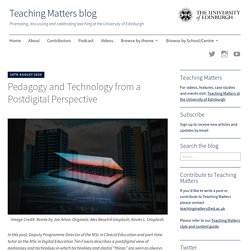
I have heard lots of colleagues over the years say that pedagogy should drive technology, rather than vice versa. This is neatly illustrated by Michael Sankey’s image of the horse of pedagogy driving the cart of technology. However, for me, this is a false dichotomy. Pedagogy and technology are not separate because pedagogy is not just method, and technology is not just a vehicle for performing that method. (context + purpose) drives (pedagogy [which includes actual uses of technology]) You can listen to a recording of our presentation here: Fawns, T. (2019). Biesta, G.
#Remote #teaching might not be so problematic ... 10 DOs and DON'Ts in #Educational #Design. @vrtnws @BenWeyts @ddeckmyn @destandaard @demorgen @UAntwerpen. Learning theories timeline: key ideas from educational psychology. Suggestions to help prepare for using online breakout rooms as learning activities. Suggestions to help prepare for using online breakout rooms as learning activities Groupwork is a valuable part of a student’s experience as it gives them the opportunity to work with peers and develop more confident teamwork and communication skills (amongst many other skills).
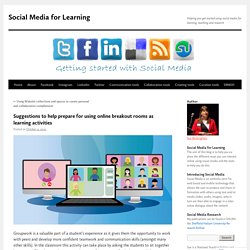
In the classroom this activity can take place by asking the students to sit together in groups or if in a lecture theatre type classroom form groups of pairs by row and then one pair turn around to form a four with the pair behind. You might ask the groups to find a space of their own and return to the classroom after a set time. In these smaller groups students can be asked to work on a problem, engage in discussions, or any other activity they can work on collaboratively. However when teaching online the use of video conferencing at first glance may not appear to be conducive of groupwork. Provide clear instructions for the breakout activity that students can access prior to and during the activity.
Like this: Reduced transactional distance and online community – Explorations in the ed tech world. At the start of COVID, I hastily wrote a post about teaching online using email and a phone.
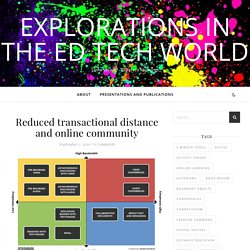
I wrote that post because I was concerned that faculty and institutional support staff would be overloaded with trying to move courses into a learning management system, which isn’t always an easy undertaking. How Can We Make the Most of Synchronous and Asynchronous Time in Distance Learning? As we look forward to the fall in which many schools will continue in a distance learning model to begin the year, we know that the Herculean effort that has been referred to as emergency remote learning taught us a lot about how we might better design learning experiences in the fall both in person and in a remote or distance learning model.
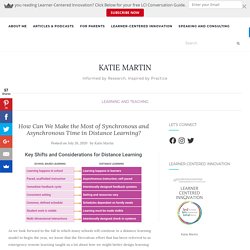
One of the most important perspectives that should inform next steps is that of the students. YouthTruth surveyed over 40,000 students and the first finding of the report is: Only half of students said their teachers give them assignments that really help them learn and 39 percent said they learn a lot every day.YouthTruth Student Survey. Not Taking Bad Advice: a Pedagogical Model. The text for my flipped keynote at Digital Pedagogy Lab 2020.

I’ve never created a model for online, digital, or hybrid pedagogies. As long as I’ve been teaching, and as long as I’ve been teaching teachers, I’ve encountered, been flummoxed by, or have cast off models. I have yet to see a single pedagogical model worth its salt. And yet I watch how quickly models spread. The neater and tidier the model, the more likely it seems to be broadly adopted by an institution: Learning Styles, Bloom’s Taxonomy, ADDIE, Scaffolding, Design Thinking, Quality Matters, Andragogy, HyFlex. QAA publishes 'building a taxonomy for digital learning' While the majority of UK universities intend to offer some onsite teaching next term, most have nonetheless had to move quickly to a greater use of digital delivery.

But how should universities and colleges describe the digital education on offer next year in a way that is clearly understood across the sector, and ensures students know what kind of experience they’ll be getting? Following discussions with senior leaders and educators from across the higher education sector, QAA has published new guidance - Building a Taxonomy for Digital Learning - which aims to help build a common language to describe digital approaches to programme delivery. In doing so, the guidance will help education providers explain what students can expect from their programmes and allow them to better understand the differences between the learning experiences on offer. When should we choose to teach live rather than asynchronously? – Dr Robert O'Toole NTF.
In an earlier article, I dissected a sophisticated learning design for live online active learning, with responsive teaching, peer-learning and group work in breakout rooms.
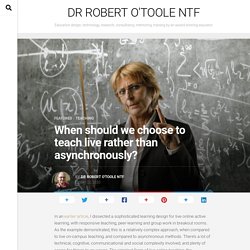
As the example demonstrated, this is a relatively complex approach, when compared to live on-campus teaching, and compared to asynchronous methods. There’s a lot of technical, cognitive, communicational and social complexity involved, and plenty of scope for things to go wrong. The simplest form of live online teaching, the live-streamed lecture, reduces these risks, but at the same time has little additional value over sharing a pre-recorded lecture. We can combine pre-recorded lectures with other kinds of asynchronous collaboration, including discussion forums and tasks, as well as shorter, less risky, live Q&A sessions (as in this example).
Designing learning and assessment in a digital age. Introduction In this guide, we focus on elements of learning and assessment design that research tells us are significant in both the higher and further education and skills sectors.
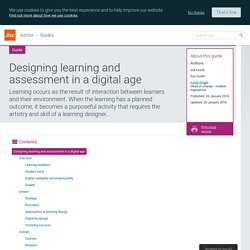
Drawing on interviews with staff in colleges and universities, and a decade of research into technology-enhanced curriculum design, we explore how digital tools can make a difference to the art of learning design. The state of the learning profession: Neuromyths and (lack of) evidence-informed practice. Mirjam Neelen & Paul A.
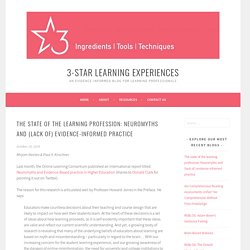
Kirschner Last month, the Online Learning Consortium published an international report titled Neuromyths and Evidence-Based practice in Higher Education (thanks to Donald Clark for pointing it out on Twitter). The reason for this research is articulated well by Professor Howard-Jones in the Preface. He says: Educators make countless decisions about their teaching and course design that are likely to impact on how well their students learn. The research. Resources & Media – Ciel Associates. Paul Kleiman: All publications (PDF) Paul Kleiman ALL PUBLICATIONS (Jan 2018) Selected Articles PAUL KLEIMAN (2017) “We Don’t Need Those Learning Outcomes”: assessing creativity and creative assessment.

Case Study 2 in Elkington, S. & Evans, C. Connected Curriculum: a framework for research-based education. Mick Healey. “Mick is like a human rolodex for active pedagogies. He is an amazing source of the world’s great ideas on learning and teaching in higher education.” Randy Bass, Georgetown University, Washington DC “Mick you’ve done something really, really useful and lots of us are very grateful to you for your assiduousness and stamina. Well done and thank you very much.” Sally Brown, Independent “Thank you for these fantastic resources and being so generous in sharing them!”
“I wanted to thank you for the wonderfully compiled resources and bibliographies, that I am sure are serving many institutions” Joanna Renc-Roe, Central European University The following bibliographies and case studies have been downloaded 70,000 times in the last seven years. Bibliographies. eLaHub eLearning accessibility training, consultancy and creation services. Valuing multilingual students’ skills. Having a deep understanding of multilingual students’ interests, skills, and experiences can be a challenge for any teacher in a busy classroom, but new research is proving how important it is to do so.
Dr Jacqueline D’warte from the School of Education at Western Sydney University has undertaken research into multilingualism in schools by actively involving teachers and students as co-researchers. The research focuses on how language and literacy practices improve student confidence and enhance learning outcomes. Funded by the New South Wales Department of Education, this study was borne out of D’warte’s desire to understand what each student brings to the classroom, and to draw out how teachers can build on that knowledge. ‘Some of the teachers in those classrooms are thinking, “Well I have all these students who come from lots of different places and often speak different languages, how do I build on that knowledge that they’re bringing to school?”’
D’warte says. Undertaking the study. A manifesto for being a part of strategic pedagogical change. Where we hope our students will engage and thrive in the theoretical and practical communities created through our learning design, teaching and assessment, the same cannot be said of how we initiate and implement teaching and learning change from an institutional through to curricular level. Driven by the sometimes-disruptive predictions for the future of our Universities, pedagogical change is often seen as the panacea for all manner of strategic threats or the rocket fuel to take advantage of the opportunities the new environment affords.
Introduction – Foundations of Learning and Instructional Design Technology. The Past, Present, and Future of Learning and Instructional Design Technology Richard E. West Like most, I had a serendipitous beginning to my career in this field. I knew I loved to teach but did not know what subject. I loved to read and study theory as a literature major but did not want to spend my life writing another literary analysis of Chaucer. I’ve learned over the years that my experience is more common than not, as there is not “a proper way” (see Lloyd Rieber’s Peter Dean lecture, republished in this book) to come into this field. Welcome to The Inclusive Design Guide. “Accessible” is not the same as Inclusion. Do we consider all learners when embedding digital into teaching, learning and assessment? If they don’t have the newest device, good connectivity, unlimited data, can they still participate, engage and learn, what if they have a disability?
‘Students don’t necessarily want more digital – they just want it used better’ Designing learning and assessment in a digital age. Designing learning and assessment in a digital age.
What If? And What’s Wrong? – Sherri Spelic. Lecture-Based Pedagogy and the Pitfalls of Expertise – The Tattooed Professor. Every few months, higher education is witness to a curious ritual where one’s stance on particular pedagogical issues assumes an affect of Calvinist-style salvation or damnation. You can set your watch by the recurring debate over laptops in the classroom. Evidence-based practice: The definition and explanation of. The principles of learning to design learning environments. Re-Thinking Design for the Inclusion of Marginalized Learniners Workshop #OEB17 #TowardsOpenness. Beniko Mason's Website. Designing for forgetting – Alastair Somerville. I have for the last few years tried to publicly prototype the ideas I am interested in and then converted into workshops.
An interesting flaw in Cognitive Load Theory. Play Matters: Six Play-Full Practices For Higher Education. 43 22Share Synopsis. Ten Teaching Trends from the Innovating Pedagogy Report - TeachOnline. Subjectivity, Rubrics, and Critical Pedagogy – OFFICE OF DIGITAL LEARNING. In “Embracing Subjectivity,”مها بالي (Maha Bali) argues “that subjectivity is the human condition. Everything else that attempts to be objective or neutral is pretense. It is inauthentic. It is not even something I strive towards.” OLCreate: Dyslexia and Inclusive Practice Introduction to Dyslexia and Inclusive Practice. The principles of learning to design learning environments. How is learning to speak different from learning to read and write? – Richard Olsen's Blog.
12 Principles Of Modern Learning - 5 Big Ideas In Education That Don't Work : NPR Ed.
Peer-Driven Learning – College Ready Writing 1.0. Osez la classe inversée à l’université ! Vulnerability in the Curriculum: No one cares about your soup! – lawrie : converged. Developing accessible web content - Technology Enhanced Learning. The Quiet and Careful Revolution of OER. Equality Challenge Unit Competence standards and reasonable adjustments: modern languages. Using technology to improve curriculum design. Top 20 principles from psychology for teaching & learning.
7 Essential Principles of Innovative Learning. The Nature of Learning: Using Research to Inspire Practice. Reimagining learning for a post-digital world (part 1) – Solutions not problems. Design_Patterns_for_Open_Online_Teaching_and_Learning_42. Pedagogical planner. Learning Design Issues for ILDC#3: Move-it-online! Course Resource Appraisal Model. Course Resource Appraisal Model. Untitled. Technology Integration Matrix.
Collaborating across borders: OER use and open educational practices within the Virtual University for Small States of the Commonwealth. Bespoke E-learning vs. Off-the-shelf Courses. More Than Blended Learning. The Top 10 Things You Should Know About Teaching Online. Paper: Review of pedagogical models and frameworks. TEC-VARIETY by Curtis J. Bonk and Elaine Khoo. CALL@Hull: OTiS Online Tutoring E-book. The Forgetting Curve in eLearning: What eLearning Professionals Should Know. TEC-VARIETY by Curtis J. Bonk and Elaine Khoo. Journal of Learning Development in Higher Education. New EUA Publication: ‘E-learning in European Higher Education Institutions’
Blended Learning. Welcome to eLearning Guidelines. HOME. The Conundrum of Talking about Access, Equity, and Diversity. App Evaluation. Rubric for Digital-Age Learning Experiences & Assessments - educational technology. Designing according to cognitive theory of multimedia design in one place. Mapping tools. The Learning Curve. Teachers as designers: a new book on teaching with technology [Interview] Draft Copyright and Rights in Performances (Research, Education, Libraries and Archives) Regulations 2014.
Doing what comes naturally SmartBlogs. Language learning: what motivates us?
Serious eLearning Manifesto. Student engagement in online content-based lear. Why online teaching requires rigorous training (Mary Burns. We Need to Educate to Create New Knowledge. Improving Learner Motivation for eLearning. Leading Innovation = Vulnerability. The proposed exceptions to copyright law offer greater flexibility to teaching and research activities. Writing on surfaces in learning spaces. E-Tivities Stories from the front line- Ale Armellini - Gilly Salmon. E-Tivities Stories from the front line- Ale Armellini - Gilly Salmon. Assessment and Feedback Topics.
Teachers learning about and with ICT as collaborative design. 10 Expectations. CC/LTI Conformance Directory.